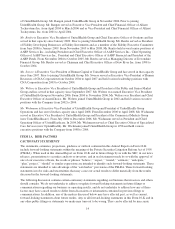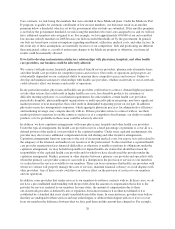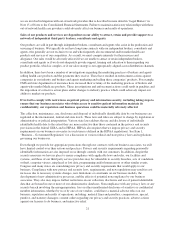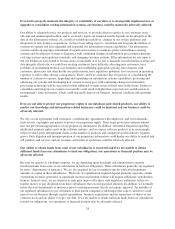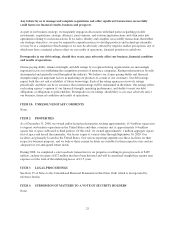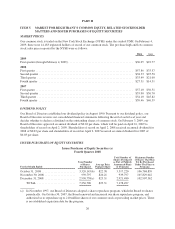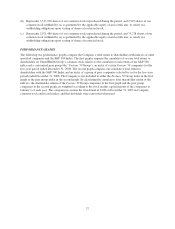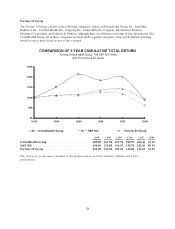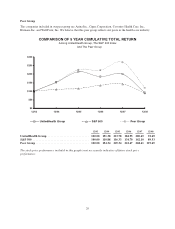United Healthcare 2008 Annual Report Download - page 29
Download and view the complete annual report
Please find page 29 of the 2008 United Healthcare annual report below. You can navigate through the pages in the report by either clicking on the pages listed below, or by using the keyword search tool below to find specific information within the annual report.We believe that barriers to entry in many markets are not substantial, so the addition of new competitors can
occur relatively easily, and customers enjoy significant flexibility in moving between competitors. In particular
markets, competitors may have capabilities or resources that give them a competitive advantage. Greater market
share, established reputation, superior supplier or health care professional arrangements, existing business
relationships, and other factors all can provide a competitive advantage to our businesses or to their competitors.
In addition, significant merger and acquisition activity has occurred in the industries in which we operate, both as
to our competitors and suppliers (including hospitals, physician groups and other care professionals) in these
industries. Consolidation may make it more difficult for us to retain or increase customers, to improve the terms
on which we do business with our suppliers, or to maintain or advance profitability. If we do not compete
effectively in our markets, if we set rates too high or too low in highly competitive markets, if we do not design
and price our products properly and competitively, if we do not provide a satisfactory level of services, if
membership or demand for other services does not increase as we expect, if membership or demand for other
services declines, or if we lose accounts with more profitable products while retaining or increasing membership
in accounts with less profitable products, our business and results of operations could be materially adversely
affected.
As a payer in various government health care programs, we are exposed to additional risks associated with
program funding, enrollments, payment adjustments and audits that could adversely affect our revenues,
cash flows and financial results.
We participate in various federal, state and local government health care coverage programs, including as a payer
in Medicare Advantage, Medicare Part D, various Medicaid programs and SCHIP, and receive revenues from
these programs. These programs generally are subject to frequent changes, including changes that may reduce the
number of persons enrolled or eligible, reduce the amount of reimbursement or payment levels, or increase our
administrative or health care costs under such programs. Such changes have adversely affected our financial
results and willingness to participate in such programs in the past, and may do so in the future.
Our participation in the Medicare Advantage, Medicare Part D, and various Medicaid programs and SCHIP
occurs through bids that are submitted periodically. Revenues for these programs are dependent upon periodic
funding from the federal government or applicable state governments and allocation of the funding through
various payment mechanisms. Funding for these government programs is dependent upon many factors outside
of our control, including general economic conditions at the federal or applicable state level, and general political
issues and priorities. A reduction or less than expected increase in government funding for these programs or
change in allocation methodologies may adversely affect our revenues and financial results.
CMS uses various payment mechanisms to allocate funding for Medicare programs, including determining
payments by considering the risk status of our Medicare members as supported by provider medical record
documentation. Federal regulators audit the supporting documents and can revise payments based on the audit
findings. CMS announced in 2008 that it will perform audits of selected Medicare health plans each year to
validate the coding practices of and supporting documentation maintained by care providers. These audits
involve a review of medical records maintained by providers, including those in and out of network, and may
result in retrospective or prospective adjustments to payments made to health plans pursuant to CMS Medicare
contracts. Certain of our plans have been selected for audit. The first audits focused on medical records
supporting risk adjustment data for 2006 that were used to determine 2007 payment amounts. We are unable to
predict the outcome of the audits. However, a material adjustment could have a material effect on our financial
results.
Our ability to retain and acquire Medicare, Medicaid and SCHIP enrollees is impacted by bids and plan designs
submitted by us and our competitors. Under the Medicaid Managed Care program, state Medicaid agencies are
periodically required by federal law to seek bids from eligible health plans to continue their participation in the
acute care Medicaid health programs. If we are not successful in obtaining renewals of state Medicaid Managed
19







